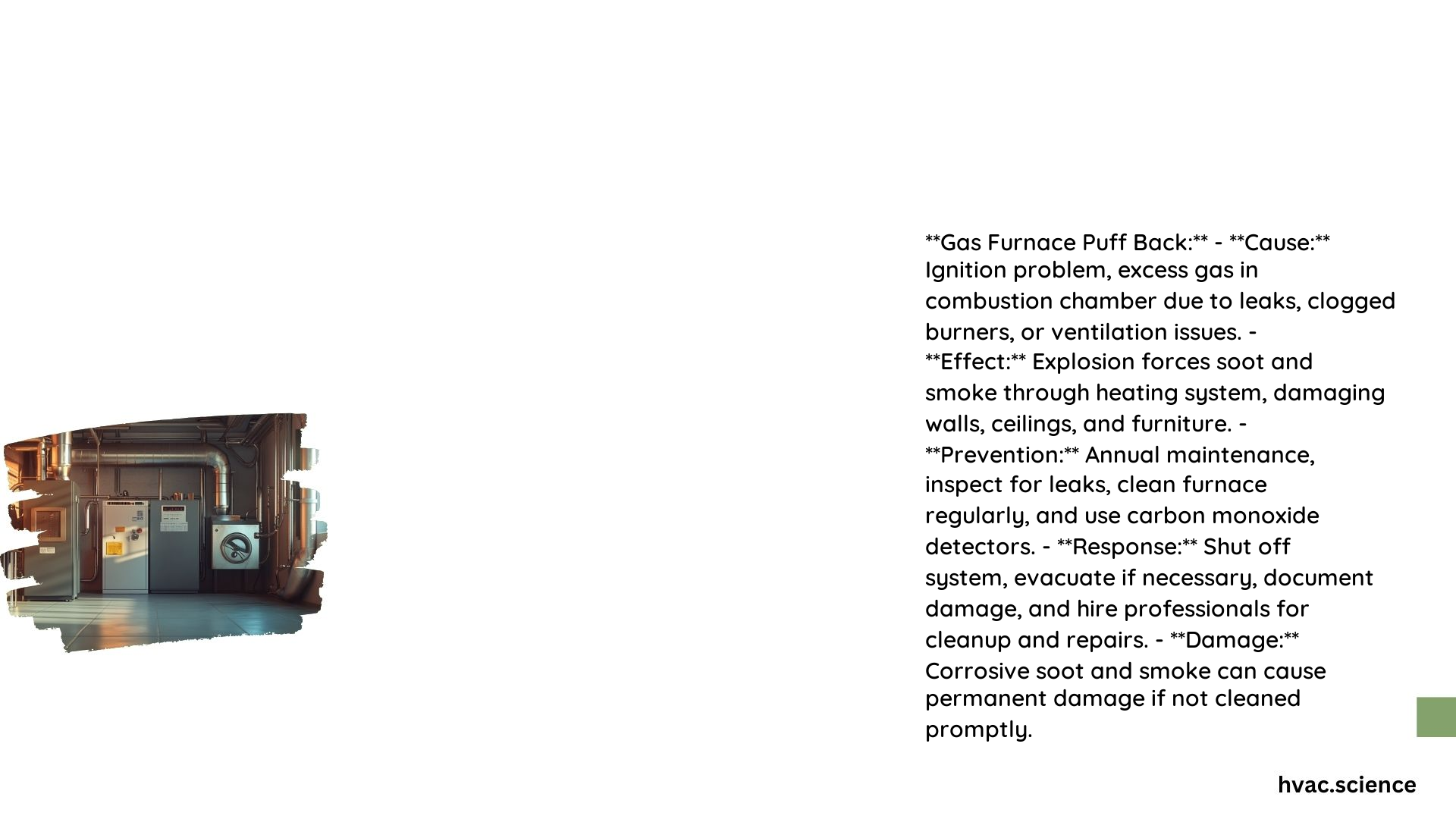What is a Puff Back in a Gas Furnace?
A puff back in a gas furnace is a sudden, explosive ignition of accumulated gas within the furnace’s combustion chamber. This can result in a loud bang, smoke, and potential damage to the furnace and surrounding areas.
What Causes a Puff Back in a Gas Furnace?

Improper Combustion
- Delayed Ignition: When the ignition of the gas is delayed, it allows gas to accumulate in the combustion chamber. Upon ignition, this accumulated gas can cause a puff back.
- Incorrect Fuel to Air Ratio: If the mixture of fuel and air is not optimal, it can lead to incomplete combustion, causing unburned fuel to accumulate and eventually ignite in a puff back.
Blocked Flue or Venting Issues
- Clogged Exhausts: Blockages in the exhaust system can prevent combustion gases from venting properly, leading to a buildup of gases that can ignite in a puff back.
- Dirt, Dust, or Corrosion: Debris in the exhaust chimney or burner can inhibit ventilation, causing internal pressure irregularities and an incorrect fuel to air ratio, which can lead to a puff back.
Issues with the Burner Assembly
- Clogged Burners: Burners clogged with dust, dirt, or residue can cause misfires, allowing fuel to accumulate in the combustion chamber.
- Damaged or Malfunctioning Components: Problems such as cracked heat exchangers or malfunctioning shutdown valves can also contribute to puff backs.
Other Mechanical Failures
- Leaks in the System: Leaks in the gas supply piping can allow gas to accumulate in the combustion chamber, leading to a puff back.
- Manual Reset Issues: Manually resetting the system too many times can cause fuel to accumulate, leading to a puff back when ignition occurs.
How to Prevent a Puff Back in a Gas Furnace?
Regular Maintenance Schedules
- Annual Inspections: Hire a professional technician to inspect and clean your heating system annually. This includes checking for leaks, cleaning the burners, and ensuring proper ventilation.
- Cleaning the Furnace: Regularly clean the area around your heating system to ensure it is free of debris and dust.
Recommended Inspection Frequencies
- Monthly Checks: Check for visible signs of soot, smoke, or unusual noises from the furnace. Listen for loud banging or rumbling sounds, which can indicate a problem.
- Seasonal Checks: Before the heating season starts, ensure that the furnace is in good working condition. Check for gas or oil leaks and ensure all valves, piping, and connectors are intact.
Specific Tools Required for Checks
- Carbon Monoxide Detector: Install a carbon monoxide detector near your heating system to alert you to potential issues.
- Combustion Analyzer: Use a combustion analyzer to check the fuel to air ratio and ensure proper combustion.
HVAC Standards and Best Practices
- Follow Manufacturer Guidelines: Adhere to the manufacturer’s maintenance and inspection recommendations for your specific furnace model.
- Industry Standards: Ensure that all maintenance and repairs are done according to industry standards and best practices, such as those outlined by the National Fire Protection Association (NFPA) and the American Society of Heating, Refrigerating and Air-Conditioning Engineers (ASHRAE).
What to Do After a Puff Back Occurs?
Immediate Actions
- Turn Off the Furnace: Immediately turn off the heating system to prevent further damage.
- Evacuate if Necessary: If there is significant smoke or a risk of fire, evacuate the property and call emergency services if necessary.
- Document the Damage: Take photos of the furnace and the damaged areas for insurance purposes.
Safety Precautions
- Avoid Cleaning Soot Yourself: Do not attempt to clean the soot yourself, as this can worsen the damage. Instead, contact a professional restoration service.
- Check for Carbon Monoxide: Ensure that there is no carbon monoxide present in the home. If your carbon monoxide detector goes off, evacuate the property and call 911.
Assessment of Damage
- Professional Inspection: Have a professional heating technician inspect the furnace to determine the cause of the puff back and recommend necessary repairs.
- Restoration Services: Contact a professional restoration service to clean up the soot and smoke damage. They will have the necessary equipment to remove odors and clean affected areas.
Necessary Repairs
- Repair or Replace Damaged Components: Based on the inspection, repair or replace any damaged components such as clogged burners, cracked heat exchangers, or malfunctioning valves.
- Clean and Inspect Ductwork: Clean and inspect the ductwork to ensure it is free of soot and debris.
Potential Costs
- Cleanup and Restoration: The cost of cleanup and restoration can vary depending on the extent of the damage. It may include costs for cleaning, replacing damaged materials, and restoring personal items.
- Repair Costs: The cost of repairs will depend on the specific components that need to be fixed or replaced.
